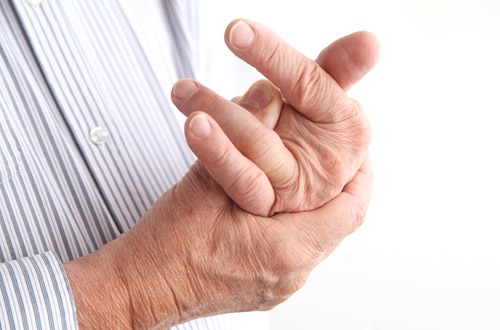Arthritis is a disease that affects the joints. Although it is common among the aged, men, women, and children across all ages are also at risk. Arthritis erodes the cartilage, which provides cushioning between the joints. This leaves the synovial lining, which produces fluid that helps lubricate and protect the joint, susceptible to irritation and inflammation. Arthritis can prevent normal functioning of the body by hindering movement and causing pain. Arthritis in fingers occurs when the joints of the hands are affected. Read on to find out the causes, treatment and symptoms.

Causes and Symptoms of Finger Arthritis
Causes
While the cause of finger arthritis is still unknown, many scientists believe that it is a genetic condition. This means that you’re more likely to get it if someone in your family. If you have a family history of arthritis, you need to do a blood test. If you have the mutated STAT gene, you have high chances of developing arthritis. Inflammation is usually triggered by an event such as an infection. Arthritis can also be triggered by hormone changes. This is why it is more prevalent in women.
Symptoms
It is important that you take note of any signs of arthritis because its symptoms can be irregular. Also known as Rheumatoid Arthritis (RA), this condition exhibits mild, moderate and severe symptoms, which appear in seasons. Some of the signs are physical and you will notice them easily. Below are some of the symptoms of arthritis in fingers you should watch out for:
Swollen fingers
Inflammation of the joints or pain in the hands
Stiffness
Poor movement
Inability to use the fingers properly
Knobby or misshapen finger joints
Soft and warm hand and finger joints
Fatigue
Numbness or tingling feeling on the hands
How to Deal with Arthritis in Fingers
Take Medication
Before you take any medication for RA, get proper diagnosis. Visit a rheumatologist or an arthritis specialist for physical examination and a scan. Once you confirm that you have finger arthritis, you can get prescriptions for proper medication, including pain relievers and disease control medication. You may have to get on a progressive treatment program if the arthritis is irreversible. Early treatment helps to prevent continuous damage to other joint areas. Some of the drugs used to treat arthritis include sulfasalazine and methotrexate. Make sure to ask your doctor about the side effects of the medication they prescribe.
Exercise
To keep your hands strong and flexible, work out regularly. Find out from an occupational therapist some of the best exercises for your hands and fingers. Squeeze and relax a soft ball to improve your grip. Exercise the affected joints in order to reduce pain and build muscle. Stretching then fingers and twisting the wrists will help you relieve pain. Exercising the fingers does not mean overworking them. Allow your hands to rest. The video below shows helpful exercises:
Get Some Rest
Resting helps to relax the body. This is especially beneficial for the joints affected by arthritis. Ample rest improves your immunity by boosting your internal body defense systems. It is also a great way to avoid stress. Overworking the joints is not a good idea since the pain can give you sleepless nights. Find a balance by resting during the day. If you use your fingers to work, take frequent breaks and use protective gear like gloves if needed.
Reduce Strain on Fingers
To avoid aggravating the pain, learn to set up your work in a way that reduces overexertion. Avoid activities where you have to bend and stretch your fingers. Use utensils and objects that are light in weight, use accessories on the doorknob, use a lamp switch instead of the main switch and improve how you do other activities which require you to use your hands.
Manage Stress and Relax
Take a walk, and move around to distract your mind and improve your mood. This helps you to relax and it improves your sleep patterns. Try other ways of relaxing the mind such as engaging in something that you like to do.
Use Splints and Arthritis Aids
Aching joints need protection from injury. To reduce pain and swelling, you can apply slight pressure on the joints using splints or aids. Arthritis in fingers affects the cartilage in the joints, wearing them out and making them weaker. These devices will enable you to clean, cook, get dressed, move around and bathe with ease.
Watch Your Diet
You should avoid excessive consumption of foods rich in omega 6 since they can cause the body to produce pro-inflammatory chemicals. The body requires a healthy balance between omega 6 and omega 3 fatty acids. Sources of omega 6 include peanut, soy, grapeseed, and sunflower. On the other hand, studies have shown omega 3 fatty acids help reduce joint pain in people with RA. You should therefore load up on omega 3 fatty acids such as salmon and flaxseed oil. Apart from watching your omega 6 fatty acids intake, avoid foods such as sugar, saturated fats, trans-fats and refined carbohydrates.
A healthy diet improves your immune system. Avoid cigarette smoking for better health. More foods to help ease arthritis pain include garlic, tart cherries, vitamin c rich foods, cabbage, broccoli, brussel sprouts and whole grains.
Joint Supplements
Supplementing with chondroitin and glucosamine can help reduce the effects of arthritis in fingers. These two supplements are major building blocks of bone cartilage.
Surgery
If all the above treatments fail, surgery may be necessary. Consult your doctor to find out the best course of action. This might include joint fusion, removal of bone spurs and joint replacement. Joint fusion is the most widely used surgical procedure for those suffering from finger arthritis. It involves holding the joint in a fixed position to prevent any motion. You will not be able to move your fingers, but the pain will be gone forever.

View All Comments /Add Comment